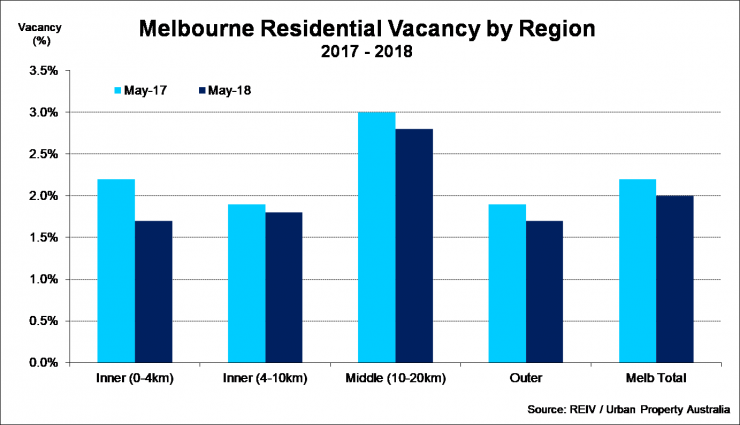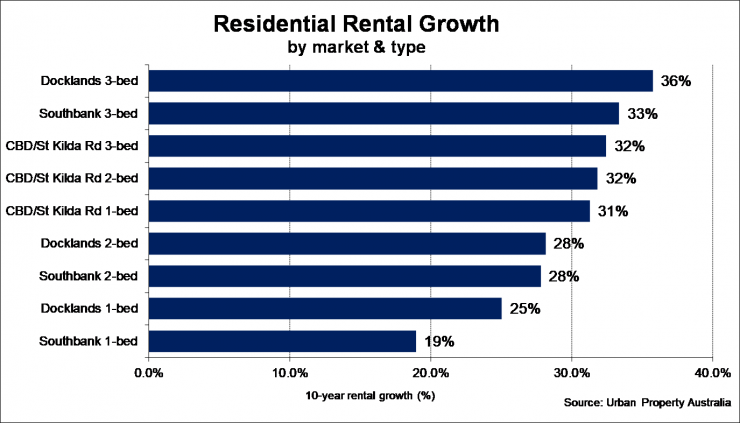Inner Melbourne Apartment Market – July 2018
July 25th 2018 | , Urban Property Australia
The development cycle of the Inner Melbourne apartment markets appears to have peaked for the medium term with the pipeline of new supply impacted by tighter lending conditions and weakening foreign investment.
Development
Between 2001 and 2016, 16,400 apartments were added to the City of Melbourne, increasing the stock by 52% over the period. In 2017, 10,269 apartments were completed in the Inner Melbourne precinct – the highest annual level on record. Of the apartments completed in 2017, 44% were located in the CBD followed with 21% located in the Docklands and 9% based in Southbank.
Currently there are 9,000 apartments under construction within the Inner Melbourne region. With 1,700 apartments already completed in 2018, Urban Property Australia research projects that 6,000 apartments will be completed this year. Of the 90 new developments currently under construction, 47% of the apartments are located in the CBD Core, followed by 20% in Southbank and 8% are located in the Docklands precinct.


Looking ahead, there are further 13,000 apartments that are being actively marketed with an additional 18,500 apartments with plans approved in the Inner Melbourne region. Although there are 8,000 apartments approved in the Fisherman’s Bend precinct; in February 2018 the State Government notified developers that 26 projects would not go ahead until permanent planning controls were put in place later this year.
Urban Property Australia’s research forecasts that the supply pipeline to continue to decline through to 2021. Development lending from major banks has tightened, limiting the number of projects that proceed to construction. Increasingly developers have also reduced the number of apartments to increase apartment internal areas to appeal to the owner-occupier market. Finally, a number of projects are likely to be converted wholly or partially to alternate uses such as offices or hotels, given the weakening buyer sentiment for apartments.
Population projections indicate that the population within the City of Melbourne will increase to 181,325 by 2031. In order to accommodate that population growth, it was forecast that a further 40,400 households would have been required.
Demand
Following more than a year of tightened lending conditions and unfavourable policy changes for investors, demand has continued to slow. Sales volumes for both new and existing stock remain well below the 10-year average. Annual sales volumes are at their lowest level since 2013.
In addition, foreign investment demand has weakened significantly, impacted by a range of factors including the Chinese government’s updated guidelines on outbound investment coupled with the introduction of state-based taxes on foreign investors.
Latest Australian Foreign Investment Review Board (FIRB) data revealed that foreign residential real estate approvals dropped significantly in the 2016/17 period. In 2016/17, foreign investment approvals for new dwellings fell by 72% compared to the previous year according to FIRB data.
In contrast owner occupier demand remains healthy, largely as a result of Melbourne’s strong population growth and increasing desire of younger generations preferring to live closer to places of work. First home buyer confidence has been boosted by additional incentives introduced in 2017 along with dwelling prices stabilizing.
Despite the record level of Inner Melbourne apartment completions in 2017, the current vacancy level of the Inner Melbourne precinct is only 1.8% as at May 2018, having fallen from 2.0% recorded in May 2017. According to the Australian Bureau of Statistics, the inner-city area of Melbourne experienced the second largest growth in Australia in 2016/17, increasing by 4,600 people (11%). The major driver of this growth was net overseas migration, which accounted for over three-quarters of population change.

Median Prices & Rents
While apartment values in the Inner Melbourne region increased by 4.2% % over the year to the March 2018 quarter, reaching $600,500, over the quarter values increased by only 0.3% which may reflect the tighter lending conditions. In March 2017, APRA announced measures to curb investor borrowing to limit interest-only lending to 30% of all new residential lending. As at July 2018, APRA will remove the 10% cap growth limit in lending to housing investors with APRA stating that the cap introduced in 2014 has served its purpose. However, Urban Property Australia believe that the removal of the investor lending cap is unlikely to have an impact, given lending standards have tightened considerably since they were introduced.
Although over 10,000 apartments were completed within the Inner Melbourne precinct in 2017, rents continue to grow above its five-year average. Inner Melbourne apartment rental levels increased by 4.6% over the year to May 2018 with a median weekly rent of rising to $450, higher than the metropolitan average of $420 per week, which increased by 5.0% over the same period.
Looking forward, the Victorian government’s vacant residential property tax (VRPT) which was introduced on 1 January 2018 may limited rental growth in the short term. Although it is unclear how the Victorian government will enforce the VRPT, this tax should increase rental supply given investors leaving properties vacant will now be penalised.
While rental growth may soften in 2018 and 2019, given the strong population growth and decreasing supply pipeline, rents are projected to above average growth from 2020.
Anecdotal evidence suggests that re-sales on recently completed developments have worsened through 2018 while sales of new stock will be under pressure largely due to the absence of off-the-plan discounts for investors and high foreign buyer duties adversely impacting foreign demand.




